Complete Solutions to Example of chapter LAWS OF MOTION : FRICTION of Class 11 book with complete answers and questions
| Class 11 | PHYSICS |
| Chapter | LAWS OF MOTION : FRICTION |
| SL ARORA | Example |
| Number Of Questions | 100 |
| Academic Year | 2023-24 |
Give the magnitude and direction of the force acting on a stone of mass 0.1 kg (a) just after it is dropped from the window of a stationary train
(b) just after it is dropped from the window of a train running at a constant velocity of `36 km//hr`
(c) just after it is dropped from the window of a train accelerating with `1 ms^(-2)`
(d) lying on the floor of a train which is accelerating with `1 ms^(-2)` the stone being at rest relative to the train .
Neglect the resistance of air throughout .03:43View SolutionA pebble of mass 0.05 kg is thrown vertically upwards Give the magnitude and direction of net force on the pebble (a) during its upward motion (b) during its downward motion (c) at the highest point where it is momentarily rest
Do your answers change if the pebble were thrown at an angle of say `45^(@)` horizontal direction lgnore air resistance .02:32View SolutionAn army vehicle of mass 1000 kg is moving with a velocity of `10 m//s` and is acted upon by a forward force of 1000 N due to the engine and a retarding force of 500 N due to friction. What will be its velocity after 10 s
01:52View SolutionA constant retarding force of 50 N is applied to a body of mass 20 kg moving initially with a speed of `15ms^(-1)` How long does the body take to stop ?
02:15View SolutionA constant force acting on a body of mass `3 kg` changes its speed from `2ms^(-1)` to `3.5 ms^(-1)` in 25 s. The direction of motion of the body remains unchanged . Calculte magnitutude and direction of the force .
01:50View SolutionA bullet of mass 40g moving with a speed of `90ms^(-1)` enters a heavy wooden block and is stopped after a direction of 60cm. The average resistive force exered by the block on the bullet is
03:43View SolutionA force of 72 dyne is inclined to the horizontal at an angle of `60^(@)`. Find the acceleration in a mass of 9 g, which moves in a horizontal direction.
02:06View SolutionA body of mass 5 kg is acted upon by two perpendicular forces 8 N and 6 N Give the magnitude and direction of the acceleration of the body .
02:29View SolutionThe driver of a three wheeler moving with a speed of `36 km//h` sees a child standing in the middle of the road and brings his vehicle to rest in 4 s just in time to save the child What is the average retarding force on the vehicle ? The mass of three wheeler is 400 kg and mass of the driver is 65 kg .
02:46View SolutionA car starts from rest and accelerates uniformly with 2 `ms^(-2)`. At t = 10 s, a stone is dropped out of the window 1 m high of the car. What are the (i) velocity, and (ii) acceleration of the stone at t = `10.1` s? (Neglect air resistance). Take g = `9.8ms^(-2)`.
05:07View SolutionA body of mass 0 .40 kg moving initially with a constant speed of `10 m//s` to the north is subjected to a constant force of 8.0 N directed towards the south for 30 s Take the instant the force is applied to be t = 0 , and the position of the particle at that time to be x = 0 , predict its position at `t = -5 s , 25 s , 100 s` ?
06:28View SolutionA stream of water flowing horizontal with a speed of `15 ms^(-1)` gushes out of tube of cross sectional area `10^(-2) m^(2)` and hits at a vertical wall nearby . What is the force exerted by the impact of water, assuming that water rebounds with the same speed.
03:55View SolutionA balloon has a mass of 10 gram in air. The air escapes from the balloon at a unifrom rate with a velocity of `5 cm //s` and the balloon shrinks completely in 2.5 s . Calculate the average force acting on the balloon.
01:48View SolutionA body of mass m moves along X-axis such that its position co-ordiante at any instant t is x = `at^(4)-bt^(3)+ct`, where a, b and c are constants. What is the force acting on the particle at any instant t?
02:02View SolutionA ball of mass `0.1` kg is thrown against a wall. It strikes the wall normally with a velocity of 30 `ms^(-1)` and rebounds with a velocity of 20 `ms^(-1)`. Calculate the impulse of the force exerted by the wall.
02:33View SolutionA cricket ball of mass 150 g moving with a velocity of 15 `ms^(-1)` is brought to rest by a player in `0.05` s. Calculate the impulse and the average force exerted by the player.
02:25View SolutionA hammer weighing 1 kg moving with the speed of `10ms^(-1)` strikes the head of a nail driving it 10 cm into a wall. Neglecting the mass of the nail, calculate (i) the acceleration during impact (ii) the time interval of the impact and (iii) the impulse.
04:10View SolutionTwo billiard balls each of mass 0 .05 kg moving in opposite directions with speed `6 ms^(-1)` collide and rebound with the same speed What is the impulse imparted to each ball due to the other ?
02:38View SolutionA glass ball whose mass is 10 g falls from a height of 40 m and rebounds to a height of 10 m. Find the impulse and the average force between the glass ball and the floor if the time during which they are in contact is `0.1` s.
04:50View SolutionWhile lauching a rocket of mass `2xx 10^(4)kg` a force of ` 5 xx 10^(5) N` is applied for `20s` Calculate the velocity attained by the rocket at the end of `20s` .
01:33View SolutionA machine gun fires a bullet of mass 40 g with a velocity `1200 ms^-1`. The man holding it can exert a maximum force of 144 N on the gun. How many bullets can be fire per second at the most?
03:56View SolutionA ball moving with a momentum of `5kg ms^(-1)` strikes against a wall at an angle of `45^(@)` and is reflected at the same angle Calculate the impulse .
05:59View SolutionA batsman deflects a ball by an angle of `45^(@)` without changing its initial speed which is equal to `54 km H^(-1)` What is the impulse imparted to the ball ? Mass of the ball is 0.05 kg
05:36View SolutionFig. shows the position-time graph of a particle of mass 4 kg. What is the (i) force acting on the particle for `t lt 0, t lt 4 s, 0 lt t lt 4 s`? (ii) impulse at t = 0 and t = 4 s? Assume that the motion is one dimensional.
05:09View SolutionFigure shows the position-time graph of a particle of mass `0.04kg`. Suggest a suitable physical context for this motion. What is the time between two consecutive impulses received by the particle? What is the magnitude of each impluse?
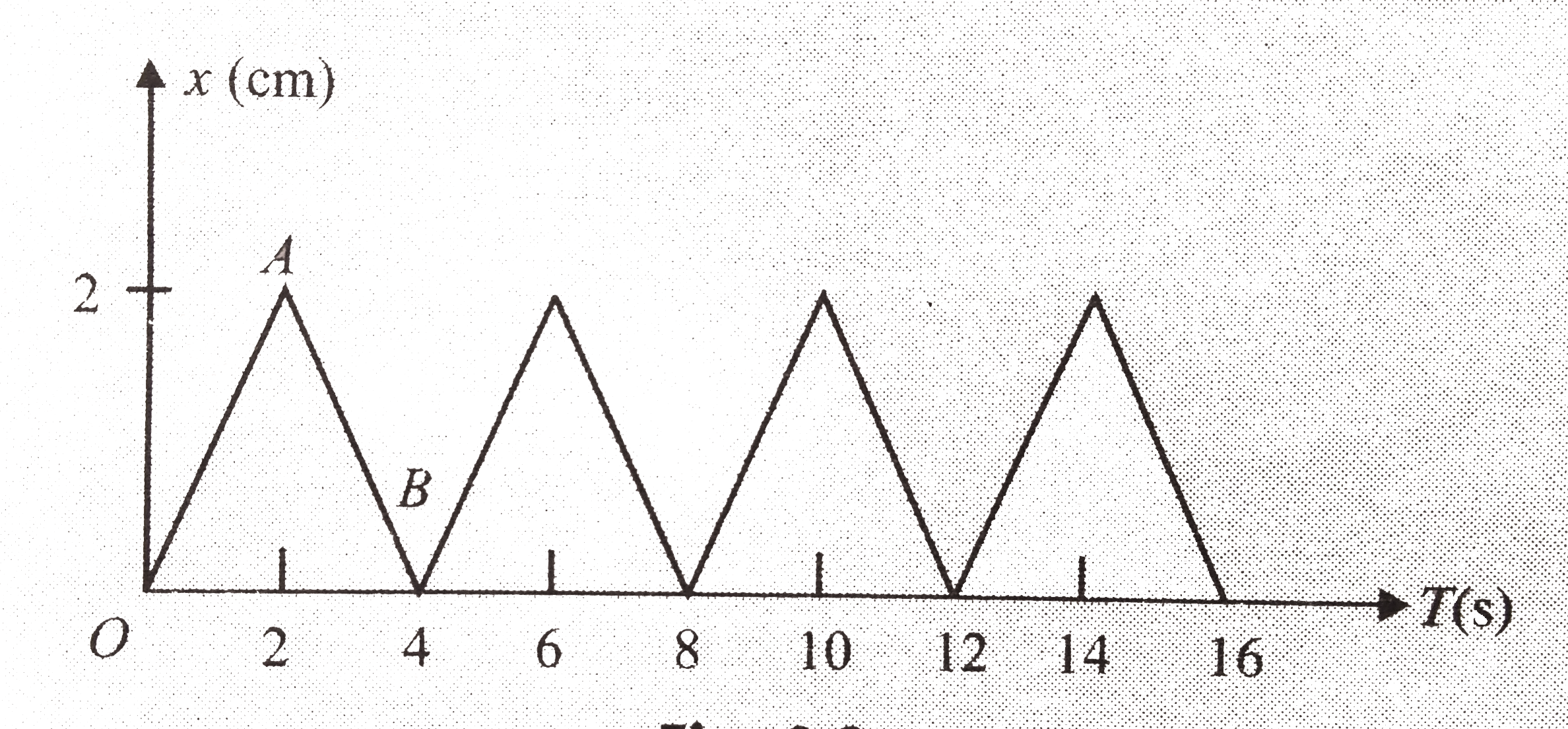 03:28View Solution
03:28View SolutionThe initial speed of a body of mass `2kg` is `5ms^(-1)` A force acts for `4` seconds in the direction of motion of the body. The force time graph is shown in Calculate impulse of the force and also find the speed of the body .
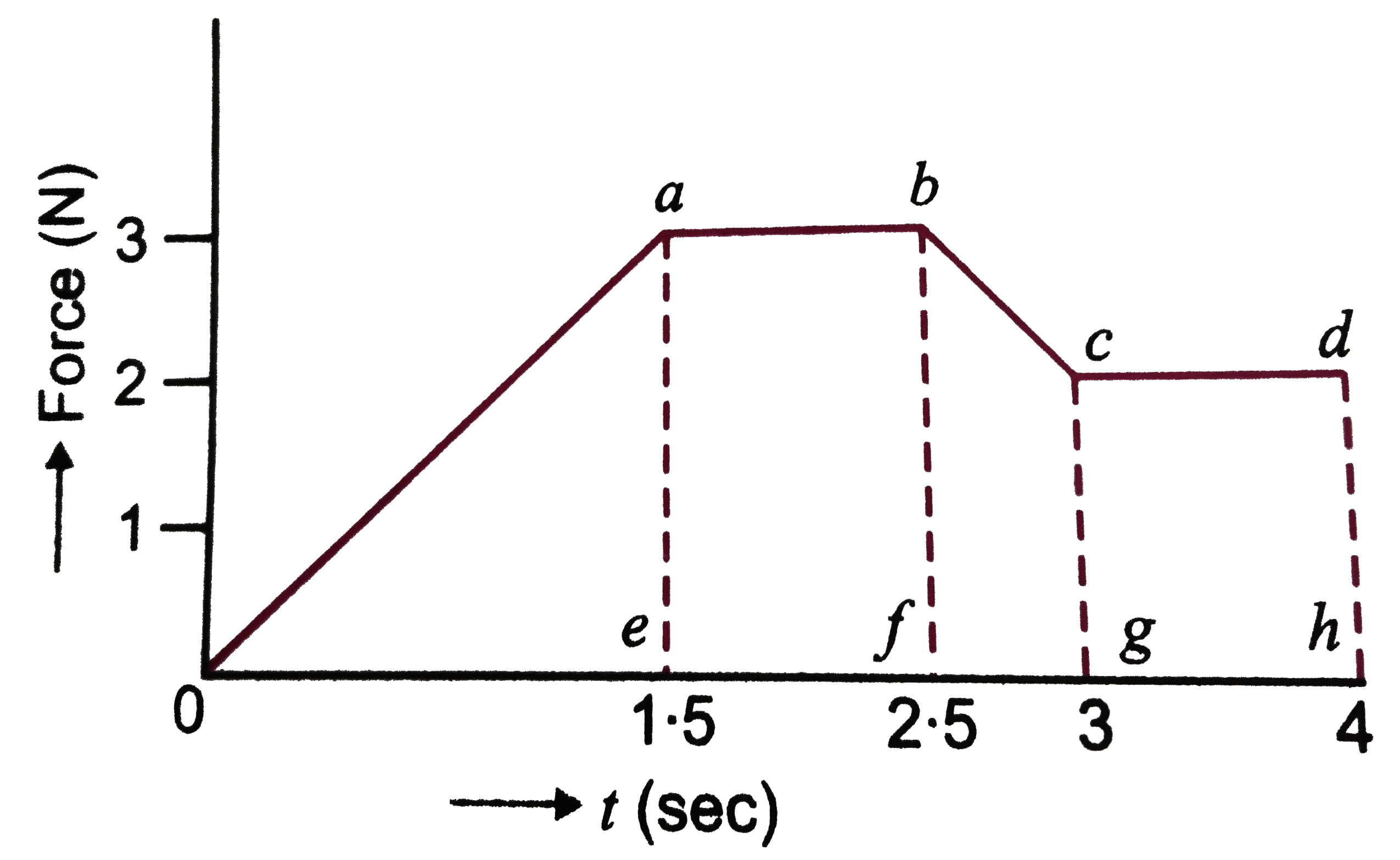 .08:27View Solution
.08:27View SolutionTen one-rupee coins are put on top each other on a table. Each coin has a mass m. The rection of the `6^(th)` coin (counted from the bottom) on the `7^(th)` coin is
02:21View SolutionAn elevator weighs `4000kg` When the upward tension in the supporting cable is `48000 N` what is the upward acceleration? Starting from rest, how far does it rise in `3` seconds ?
02:38View SolutionA man of mass 70 kg stands on a weighing machine in a lift , which is moving (a) upwards with a unifrom speed of `10ms^(-1)` (b) downwards with a unifrom acceleration of `5 ms^(-2)`
(c) upwards with a unifrom acceleration of `5 ms^(-2)` What would be th readings on the scale in each case ?
(d) What would be the reading if the lift machanism failed and it hurtled down freely under gravity ?05:18View SolutionA block of mass 25 kg is raised by a 50kg man in two different ways as shown in fig. what is the action on the floor by the man in the two cases? If the floor yields to a normal force of `700N`, which mode should the man adopt to lift the block without the floor yielding?
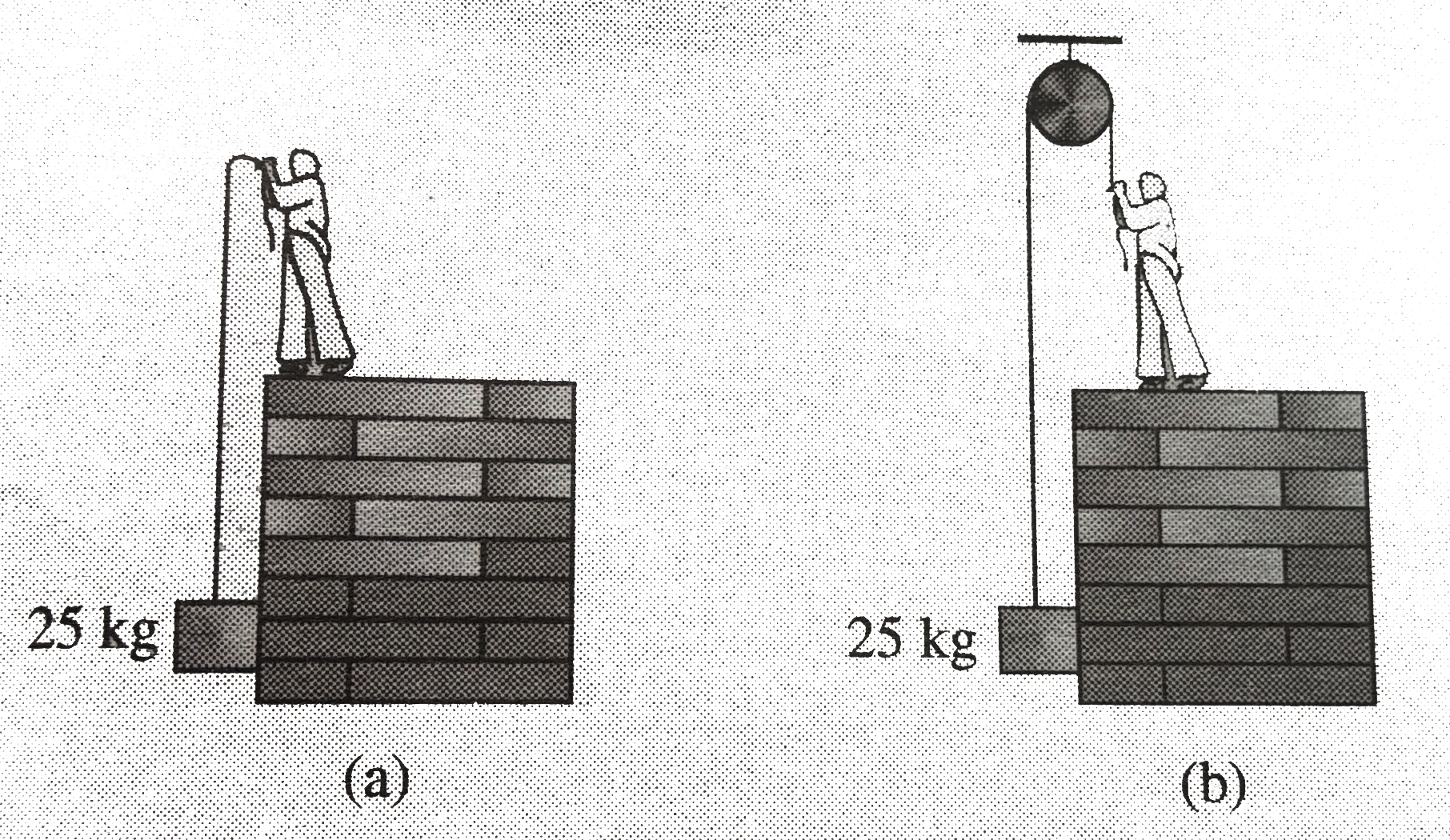 07:35View Solution
07:35View SolutionA monkey of mass 40 kg climbs on a rope which can withstand a maximum tesion of 600 N In which of the following cases will the rope break ? The monkey
(a) climbs up with an acceleration of `6 ms^(-2)`
(b) climbs down with an acceleration of `4 ms^(-2)`
(c) climbs up with a unifrom speed of `5 ms^(-1)` (d) falls down the rope nearly freely under gravity Ignore the mass of the rope .04:25View SolutionA helicopter of mass 2000 kg rises with a vertical acceleration of `15ms^-2`. The total mass of the crew and passengers is 500 kg. Give the magnitude and direction of the (g`=10ms^-2`)
(a) Force on the floor of the helicopter by the crew and passengers.
(b) action of the rotor of the helicopter on the surrounding air.
(c ) force on the helicopter dur to the surrounding air.05:00View SolutionA lift of mass 2000 kg is supported by thick steel ropes . If maximum upward acceleration of the lift be `1.2 m//s^(2)` , and the breaking stress for the ropes be
`2.8 xx 10^(8) Nm^(-2)`
what should be the minimum diameter of rope ?02:40View SolutionA shell of mass 200g is fired by a gun of mass 100kg. If the muzzle speed of the shell is `80ms^(-1)` , then the rcoil speed of the gun is
04:37View SolutionA 30 kg shell is flying at 48 `ms^(-1)`. When it explodes, its one part of 18 kg stops, while the remaining part flies on. Find the velocity of the later.
02:21View SolutionA nucleus is at rest in the laboratory frame of reference Show that if it distintegrates into two smaller nuclei the products must be emitted in opposite directions .
02:01View SolutionA neutron having a mass of `1.67 xx 10^(-27) kg` and moving at `10^(8) m//s`collides with a deuteron at rest and sticks to it. If the mass of the deuteron is `3.33 xx 10^(-27) kg` then the speed of the combination is
02:24View SolutionA car of mass 1000 kg travelling at `32 ms^(-1)` dashes into the rear of a truck of mass 8000 kg , moving in the same direction with a velocity of `4 ms^(-1)` After the collision the car bounces with a velocity of `8 ms^(-1)` What is the velocity of the truck after the impact ?
01:51View SolutionA hunter has a machine gun that can fire 50 g bullets with a velocity of `150 m//s` . A 60 kg tiger springs at him with a velocity of `10 ms^(-1)` How many bullets must the hunter fire per secoud into the tiger in order to stop him in his track.
05:27View SolutionA machine gun has a mass of 10 kg . It fires 30 gram bullets at the rate of 6 bullets per second with a speed of `400 m//s` . What force must be to the gun to keep it in position ?
04:37View SolutionA body of mass `1 kg`, initially at rest, explodes and breaks into three fragments of masses in the ratio `1:1:3`. The two pieces of equal mass fly off perpendicular to each other with a speed of `30 m//s` each. What is the velocity of the heavier fragment?
02:02View SolutionA rocket with a lift off mass 20000 kg is blasted upwards with a net initial acceleration of `5 ms^(-2)` Calculate the initial thrust (force) of the blast.
02:11View SolutionFuel is consumed at the rats of `100kg//s` in a rocket The exhaust gases are ejected at a speed of `4.5 xx 10^(4) ms^(-1)` w.r.t the rocket What is the thrust experienced by the rocket Also calculate velocity of the rocket at the instant when its mass is reduced to m/10 of rocket .
04:56View SolutionA rocket of initial mass `6000kg` ejects mass at a constant rate of `16kg//s` with constant relative speed of `11m//s` What is the acceleration of the rocket one mnute after blast ?
02:37View SolutionThe mass of a rocket is 500 kg and the relative velocity of the gases ejecting from it is 250 m/s with respect to the rocket. The rate of burning of the fuel in order to give the rocket an initial acceleration `20 m//s^(2)` in the vertically upward direction `g = 10 m/s^(2)`, will be -
03:58View SolutionA rocket is set for vertical firing If the exhaust speed is `1200ms^(-1)` , how much gas must be ejected per second to supply the thrust needed (i) to overcome the weight of rocket (ii) to give to the rocket an initial vertical upward acceleration of `29.6 m//s^(2)` Given mass of rocket = 6000 kg.
06:59View SolutionIf the maximum possible exhaust velocity of a rocket be `2km//s` calculate the ratio `m_(0)//m` for it to acquire a veocity of `11.2km//s` after starting from rest .
02:26View SolutionA rocket motor consumes 100 kg of fuel per second, exhausting it with a speed of `5xx10^(3)ms^(-1)`. (i) What force is exerted on the rocket ? (ii) What will be the velocity of the rocket at the instant its mass is reduced `(1//20)`th of its initial mass, its initial velocity being zero. Neglect gravity.
03:39View SolutionA rocket is going upward with acceleration motion. A man string in it feels his weight increased 5 time his own weight. If the mass of the rocket including that of the man is `1.0xx10^(4)kg` , how much force is being applied by rocket engine? `(Take g=10ms^(-2))` .
03:10View SolutionA balloon with mass `m` is descending down with an acceleration a (where `altg)`. How much mass should be removed from it so that it starts moving up with an acceleration a?
05:16View SolutionA mass of 6 kg is suspended by a rope of length 2 m from the ceilling A force of 50 N in the horizontal direction is applied at the mid - point P of the rope as shown . What is the angle the rope makes with the vertical in equilibrium ? (Take = `10 ms^(-2)`) . Neglect mass of the rope .
02:16View SolutionDetermine the tension `T_(1)` and `T_(2)` in the strings shown in Fig.
 01:47View Solution
01:47View SolutionA train is moving along a horizontal track . A pendulum suspended from the roof makes an angle of `4^(@)` with the vertical . If `g = 10 m//s^(2)` , what is the acceleration of the train ?
02:25View SolutionA ball of mass `1 kg` hangs in equilibrium from two strings `OA` and `OB` as show in figure. What are the tensions in strings `OA` and `OB`? `(Take g= 10 m//s^(2))`
 03:59View Solution
03:59View SolutionA body of mass m is suspended by two strings making angles `alpha and beta` with the horizontal. Find the tensions in the strings.
05:25View SolutionA horizontal uniform rope of length L, resting on a frictionless horizontal surface, is pulled at one end by force F. What is the tension in the rope at a distance l from the end where the force is applied?
02:58View SolutionA pull of 15 N is applied to a rope attached to a block of mass 7 kg lying on a smooth horizontal surface. The mass of the rope is `0.5` kg. What is the force exerted by the block on the rope?
02:26View SolutionA horizontal force of 500 N pulls two masses 10 kg and 20 kg (lying on a frictionless table) connected by a light string. What is the tension in the string ? Does the answer depend on which mass end the pull is applied?
02:30View SolutionTwo blocks of masses `m_(1)` and `m_(2)` in contact lie on a horizontal smooth surface as shown in The blocks are pushed by a force `F` If the two blocks are always in contact what is the force at their common interface
04:32View SolutionAs shown in Fig. three blocks connected together lie on a horizontal frictionless table and pulled to the right with a force F = 50 N. If `m_(1)=5kg, m_(2)=10kg` and `m_(3)=15kg`, find the tensions `T_(1)` and `T_(2)`.
 02:25View Solution
02:25View SolutionTwo masses M and m are connected at the two ends of an inextensible string. The string passes over a smooth frictionless pulley. Calculate the acceleration of the masses and the tension in the string. Given `Mgtm`.
02:52View SolutionTwo masses 7 kg and 12 kg are connected at the two ends of a light inetensible string that goes over a frictionless pulley. Find the acceleration of the masses and the tension in the string when the masses are released.
03:52View SolutionTwo bodies of masses `11kg` and `11.5kg` are connected by a long light string passing over a smooth pulley Calculate velocity and height ascended/descended by each body at the end of `4s` .
04:50View SolutionThe masses `m_(1) m_(2)` and `m_(3)` of the three bodies shown in fig . Are 5 , 2 and 3 kg respectively Calculate the valuse of tension `T_(1) T_(2)` and `T_(3)` when (i) the whole system is going upward with an acceleration of `2 m//s^(2)` (ii) the whole system is stationary ` (g=9.8 m//s^(2))` .
 . 07:27View Solution
. 07:27View SolutionA body `m_(1)` of mass 10 kg is placed on a smooth horizontal table It is connected to a string which passes over a frictionless pulley and carries at the other end , a body `m_(2)` of mass 5 kg What acceleration will be produced in the bodies when the nail fixed on the table is removed ? what will be the tension in the string during the motion of the bodies ? What when the bodies stop ? (g= 9.8 N ? kg ) .
04:12View SolutionA block of mass 100 kg is set into motion on a frictionless horizontal surface with the help of a frictionless pulley and rope system shown in What horizontal force should be applied on the rope to produce an acceleration of `0.1 m//s^(2)`
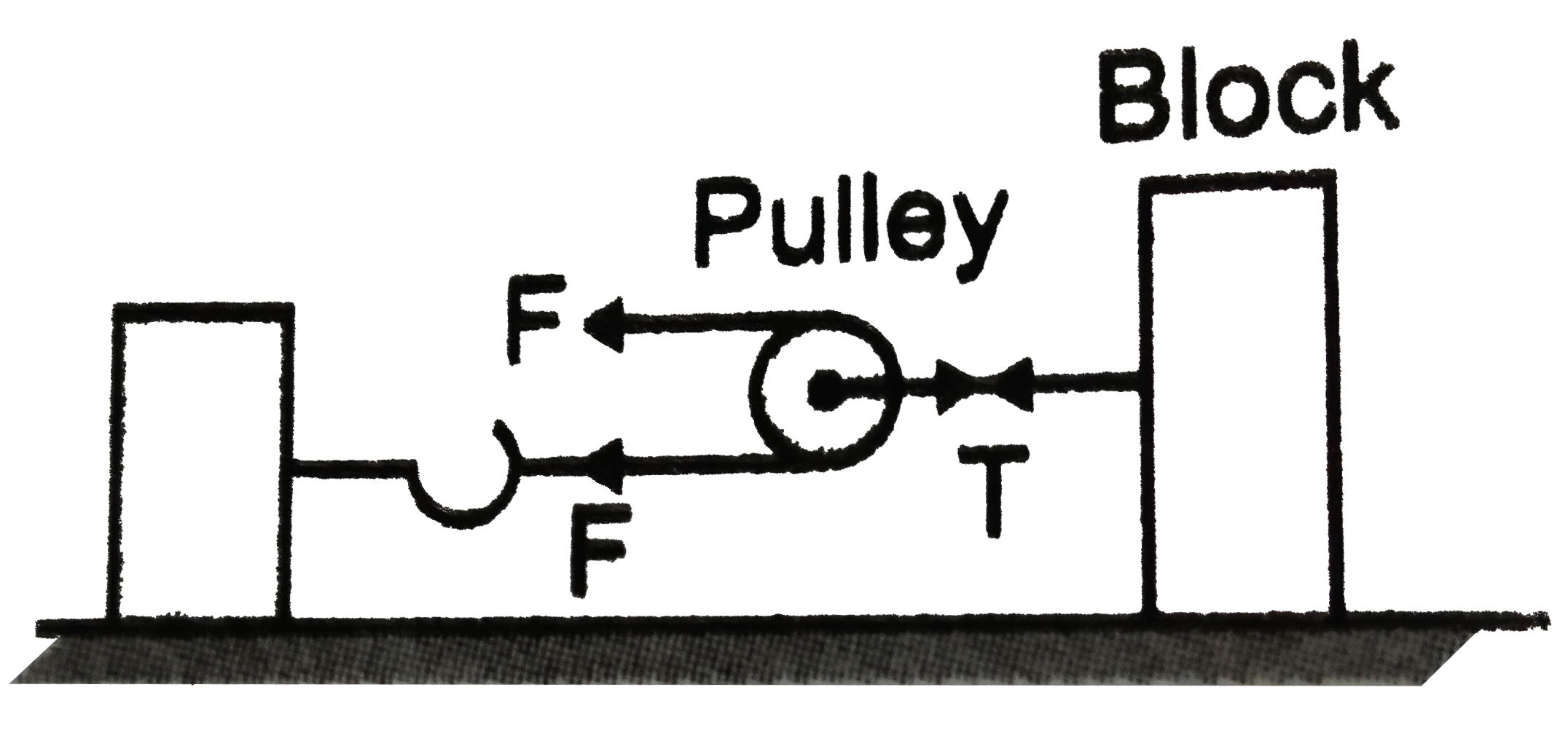 . 03:18View Solution
. 03:18View SolutionIn terms of masses `m_(1),m_(2)` and g, find the acceleration of both the blocks shown in Fig. Neglect all friction and masses of the pulley.
02:58View SolutionTwo particles each of mass `m` are connected by a light string of length `2L` as shown in the figure. A constant force `F` is applied continuoulsly at the mid`-`point of the string at right`-`angle to intial position of the string. Find the acceleration of each particle and the acceleration of approach between the particles when separation between them is `2x`
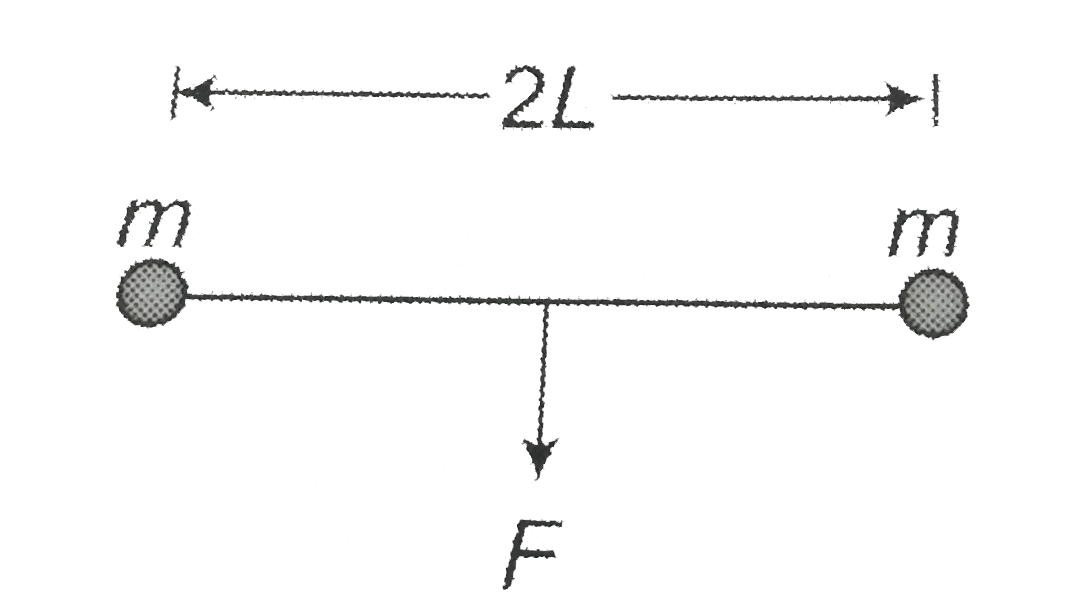 02:40View Solution
02:40View SolutionTwo blocks of masses 50 kg and 30 kg connected by a massless string pass over a light frictionless pulley and rest on two smooth planes inclined at angles `30^(@)` and `60^(@)` resp . With horizontal .Determine the accelertion in the two blocks and tension in the string `g = 10 m//s^(2)` .
05:17View SolutionA block of mass `2kg` is kept on the floor. The coefficient of static friction is `0.4` . If a force `F` of `2.5N` is applied on the block as shown in the figure, the frictional force between the block and the floor will be.
 02:37View Solution
02:37View SolutionA block of weight 20 N is placed on a horizontal table and a tension T is applied on the block . Tension can be increased to 8 N before the block begins to slide . A force of 4 N keeps the block moving at constant speed , once it has been set in motion . Find the coefficients of static friction and kinetic friction].
02:52View SolutionA force of 49 N is just sufficient to pull a block of wood weighing 10 kg on a rough horizontal surface. Calculate the coefficient of friction and angle of friction.
02:58View SolutionA cubical block rests on an inclined plance of `mu = (1)/sqrt(3)` . Determine the angle at which the block just slides down the incline .
01:38View SolutionA body rolled on ice with a velocity of `8 ms^(-1)` comes to rest after travelling a distance of 4 m . Calculate the coefficient of friction .
02:39View SolutionA mass of 4 kg rest on a horizontal plane . The plane is gradually inclined until an angle `0 = 15^(@)` with the horizontal and the mass just begins to slide . What is the coefficient of static friction between the block and the surface ?
 01:36View Solution
01:36View SolutionThe coefficient of friction between the ground and the wheels of a car between the ground and the wheels of acar moving on a horizontal road is 0.5 If the car starts from rest , what is the minimum distance in which it can acquire a speed of `72 km // h` ? take `g = 10 ms^(-2)` .
05:10View SolutionA horizontal force of `1.2kg` is applied on a `1.5kg` block , which rests on a horizontal surface If the coefficient of friction is `0.3` find the acceleration produced in the block .
02:40View SolutionA bullet of mass 0.01 kg is fired horizontal into a 4 kg wooden block block at rest , on a horizontal surface. The coefficient of kinetic friction between the block and bullet is 0.25 the combination moves 20 m before coming to rest . With what speed did the bullet strike the block ?
08:05View SolutionFigure shown a man standing stationary with respect to a horizontal converyor belt that is accelerationg with `1m//s^(-2)` . What is the net force on the man?If the coefficient of ststic friction between the man's shoes and the belt is `0.2` upto what maximum acceleration of the belt can the man continue to be stationary relative to the belt? Mass of the man`= 65kg (g =9.8m//s^(2))`
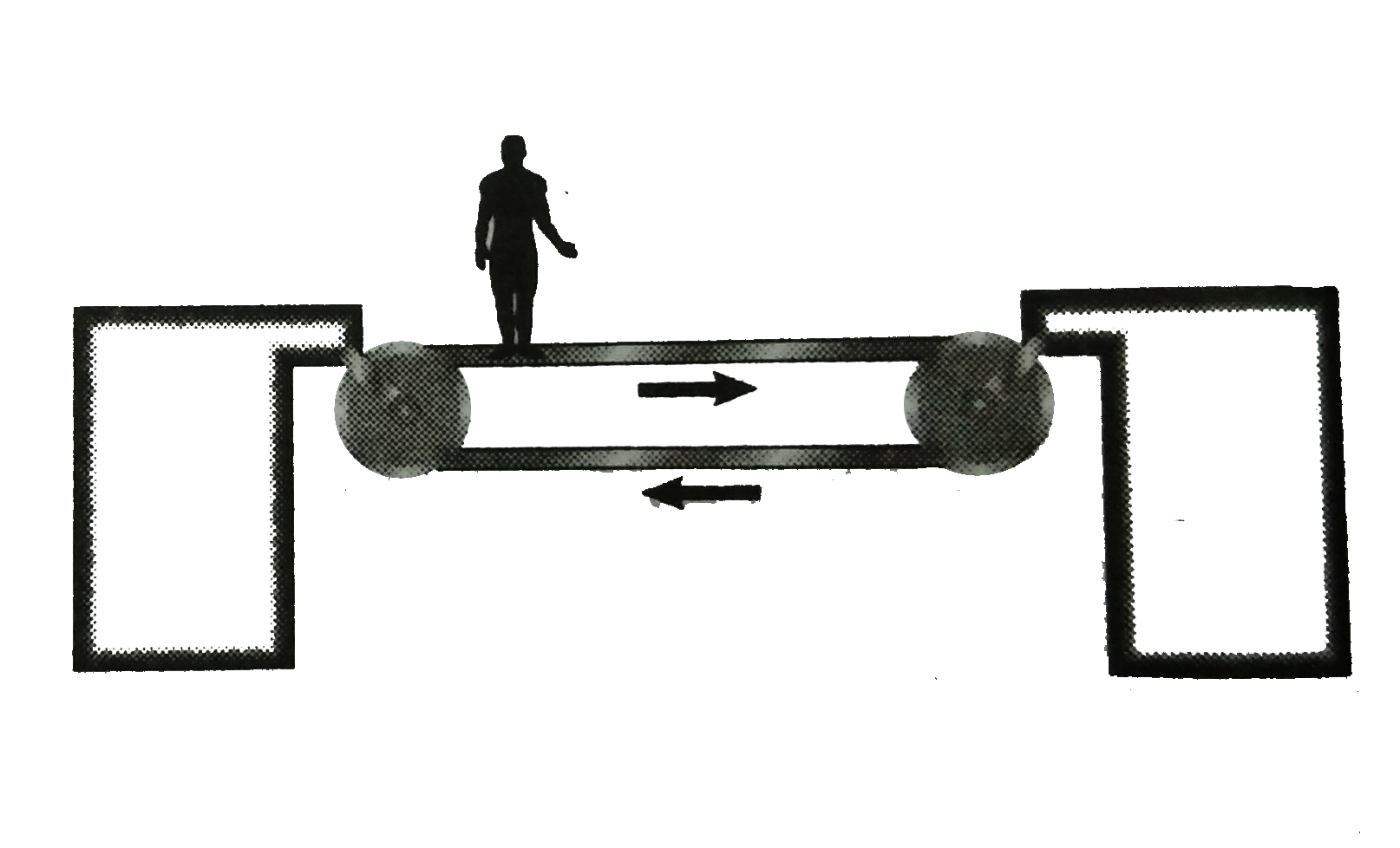 05:56View Solution
05:56View SolutionA block of mass 15 kg is placed on a long trolly . The coefficient of friction between the block and trolly is 0.18 The trolly accelerates from rest at ` 0.5 m//s^(2) ` for 20 seconds and then moves with a unifrom velocity Discuss the motion of the block as viewed by (i) a stationary observer on the ground (ii) an observer moving with the trolly .
08:55View SolutionThe rear side of a truck is open and a box of 40 kg mass is placed 5 m from the open end The coefficient of friction between the box and the surface below it is 0.15 On a straight road the truck starts from rest and accelerates with `2 m//s^(2)` At what distance from the starting point does the box fall off the truck ? Ignore the size of the box .
03:50View SolutionWhat is the acceleration of the block and trolley system shown in if the coefficient of kinetic friction between the trolley and the surface is 0 .04 ? What is the tension in the string ? Take `g = 10 ms^(-2)` Neglect the mass of the string
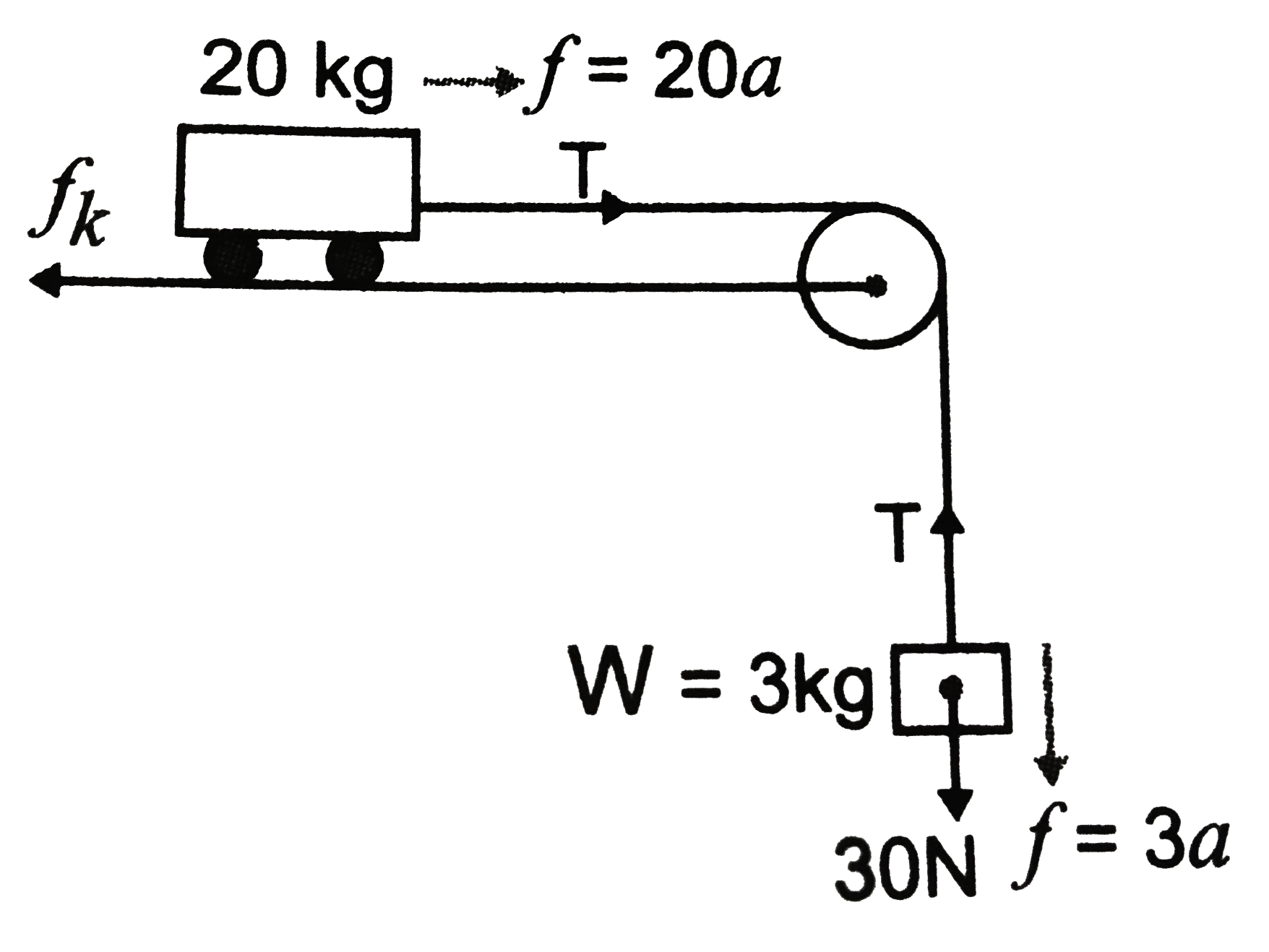 . 02:55View Solution
. 02:55View SolutionA block A of mass 4 kg is placed on another block B of mass 5 kg , and the block B rests on a smooth horizontal table . For sliding block A on B , a horizontal force of 12 N is required to be applied on A How much maximum force can be applied on B so that both A and B move togrther ? Also find out acceleration produced by this force .
04:29View SolutionTwo bodies A and B of mass 5 kg and 10 kg contact with each other rest on a table against a rigid The coefficient of friction between the bodies and the table is 0.05 A force of 200 N is applied horizontal on A What are (a) the reaction of thee wall (b) the the action , reaction forces between A & B ? What happens when the wall is removed ? Does the answer to (b) Change , when the bodies are in motion ? Ignore differnce between `mu_(s)` and `mu_(k)`
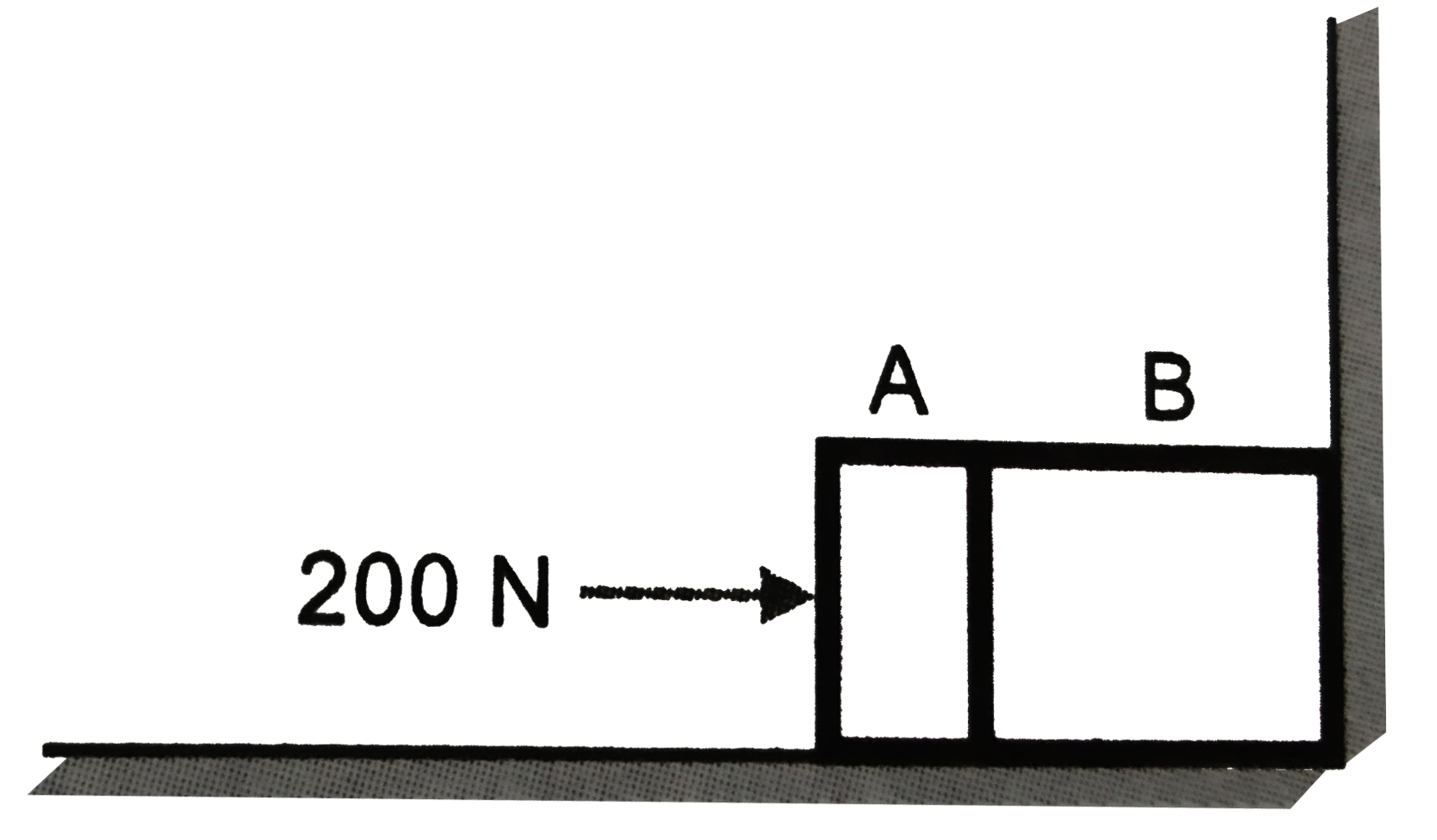 . 13:53View Solution
. 13:53View SolutionA 50 metric ton train has to run at 72 `kmh^(-1)`. If the track is level and total resistance is `(1)/(80)`th the weight of the train, find the power of the engine.
02:23View SolutionAn engine of 100 H.P draws a train of mass 200 metric ton with a velocity of `36 km // h` . Find the coefficient of friction .
02:27View SolutionA box of mass 4 kg is placed on a wooden plank of length `1.5`m which is lying on the ground. The plank is lifted from one end along its length so that it becomes inclined. It is noted that when the vertical height of the top end of the plank from the ground becomes `0.5`m, the box begins to slide. Find the coefficient of friction between the box and the plank.
03:09View SolutionA mass of 200 kg is placed on a rough inclined plane of angle `30^(@)` . If coefficient of limiting friction is `1 // sqrt 3` , find the least forces in newton , acting parallel to the plane (i) to keep the mass from sliding down (ii) to move the mass up the plane.
03:45View SolutionA box of mass `4kg` rests upon an inclined plane This inclination is gradually incresed till the box starts sliding down the plane. At this stage slope of the plane is 1 in 3 Find coefficient of friction between the box and the plane What force applied to the box parallel to the plane will just make the box move up the plane ?
05:47View SolutionA block of metal of mass 50 gram placed over an inclined plane at an angle of `15^(@)` slides down without acceleration . If the inclination is increased by `15^(@)` , what would be the acceleration of the block ?
03:05View SolutionA block is gently placed at the top of an inclined plane 6.4 m long . Find the time taken by the block to slide down to the bottom of the plane . The plane makes an angle` 30^(@)` with the horizontal Coefficient of friction between the block and the plane is 0.2 Take ` g = 10 m//s^(2) ` .
02:54View SolutionWhen an automobile moving with a speed of `36km//h` reaches an upward inclined road of angle `30^(@)`, its engine is switched off. If the coefficient of friction is 0.1, how much distance will the automobile move before coming to rest ? Take `g=10ms^(-2)`.
10:01View SolutionStarting from rest , a body slides down at `45^(@)` inclined plane in twice the time it takes to slide down the same distance in the absence of friction. The coefficient of friction between the body and the inclined plane is
09:36View SolutionA block of mass 2 kg rests on an inclined plane which makes an angle of `30^(@)` with the horizontal. The coefficient of friction between the block and the surfcae is `sqrt(3//2)`. (i) What force should be applied on the block so that it moves down without any acceleration ? (ii) What force should be applied on the block so that it moves up without any acceleration ? (iii) Calculate the ratio of the powers in the above two cases if the block moves with uniform speed in both the cases.
06:57View SolutionFind the force required to move a train of 2000 quintals up an incline of 1 in 50 , with an acceleration of `2 ms^(-2)` , the force of friction being 0.5 newton per quintal .
03:36View SolutionAn engine of weight `6.5` metric ton is going up an inclined plane of 5 in 13 at the rate of `9km//h`. If the coefficient of friction is `(1)/(120`. Calculate the power of the engine. Take `g=9.8m//s^(2)`
05:23View SolutionA body starts rolling down an inclined plane , the top half is rough . Find the ratio of the force of friction and weight of the body if the body is brought to rest just when it reaches the bottom , the angle of the plane being `30^(@)` .
05:10View SolutionA body of mass m is released from the top of a rough inclined plane of length l and height h If f is the force of friction prove that the body will reach the bottom with a velocity `upsilon = sqrt((2)/(m) (m g h - f l))` .
03:03View SolutionCalculate the height upto which an insect can crawl up a fixed bowl in the form of a hemisphere of radius r. Given coefficient of friction is `1//sqrt3`.
03:35View SolutionTwo blocks of mass 2 kg and 5 kg are connected by an ideal string passing over a pulley. The block of mass 2 kg is free to slide on a surface inclined at an angle of `30^(@)` with the horizontal whereas 5 kg block hangs freely. Find the acceleration of the system and the tension in the string. Given `mu=0.30`.
03:38View Solution
Example questions and complete solutions for chapter LAWS OF MOTION : FRICTION of DHANPAT RAI & CO PHYSICS (HINGLISH) of Class 11
